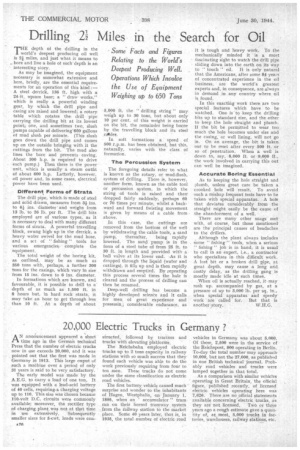Drilling 2:1 Miles in the Search for Oil
Page 28

If you've noticed an error in this article please click here to report it so we can fix it.
• Some Pacts and Figures Relating to the World's Deepest Producing Well. Operations Which Involve the Use of Equipment Weighing up to 650 Tons r-rHE depth of the drilling in the world's deepest producing oil well is 21 miles, and just what it means to bore and line a hole of such•depth is an interesting s Wry.
As may be imagined, the equipment necessary is somewhat extensive and here, briefly, are the essential requirements for an operation of this kind:—.
• A steel derrick, 136 ft. high with a 24-ft. square base; a " draw works," which is really a powerful winding gear, by which the drill pipe and casing are raised and lowered; a rotary table which rotates the drill pipe carrying the drilling bit at its lowest point;. one, and sometimes two, slush .pumps capable of delivering`600 gallons of mud slush per minute, (This slush goes down the drill pipe and comes up on the outside bringing with it the cuttings from the bit. The. mud also lines the bore and prevents caving. About 300 h.p. is requiredto drive each pump.) Then there is the power unit, which is usually a steam outfit of about 600 h.p. Latterly, however, oil power and, in some cases, electrical power have been used.
Different Forms of Strata
The drill pipe, which.is made of steel and solid drawn, measures from 3 ins. to 61. ins. diameter • and weighs from 13 lb. to 26 lb. per ft. The drill bits employed are of various types, as it is necessary to deal with many different forms of. strata. A powerful travelling block, swung high up in the derrick, a heavy water swivel for the mud hose, and a sa of " fishing" tools for various emergenciescomplete the equipment.
The total weight of the boring kit, as outlined, may be as much as 350 tons with, perhaps, a further 300 tons for the casings, which vary in size from 15 ins. down to 6 ins. diameter. , In formations which are known, and favourable, it is possible to drill to a.• depth of as much as 1,500 ft. in 8 hours but, in hard rock strata, it may take an hour to get through less than 10 ft. At a depth of about 5,000 ft. the " drilling string " may weigh up to 30 tons, but about only 10 per cent, of this weight is carried on the bit, the remainder being borne by the travelling block and its steel cables.
In soft formations a speed of 500 r.p.m. has been obtained, but this, naturally, varies with the class of formation.
The Percussion System The foregoing details refer to what is known as the rotary, or mud-flush, system of drilling. There is, however, another form, known as the cable tool or percussion system, in which the string of tools is raised and then' dropped fairly suddenly, perhaps 60 or 70 times per minute, whilst a backward and forward fwisting movement is given by means of a cable from above.
In this case, the cuttings are removed from the bottom of the well by withdrawing the cable tools, a sand pump, thereafter, being rapidly lowered. The sand pump is in the form of a steel tube of from 25 ft. to 30 ft. in length and provided with. a ball valve at its lower end. As it is dropped through the liquid (water and cuttings), it fills up and is then rapidly withdrawn and emptied. By repeating this process several times the hole is cleared and the process of drilling can then be resumed.
Deep-well drilling has become a highly developed science and it calls for men, of great experience and possessin; considerable endurance, as it is tough and heavy work. To the mechanically minded it is a most fascinating sight to watch the drill pipe sliding down into the earth on its way
to " touch " oil. It is only natural that the Americans, after some 84 years of concentrated experience in the oil business, are the world's greatest experts and, in consequence, are always in demand in any country where oil is found.
In this exacting work there are two special features which have to be watched. One is -to keep the drilling bits up to standard size, and the other to keep the hole straight and plumb. If the bit be permitted to wear. too much the hole becomes under size and the casing, or well lining, will not go in. On an average, the bit is taken out to be reset after every 500 ft. or so of penetration. When a well is down to, say, 8,000 ft. or 9,000 ft., the work involved in carrying this out can well be imagined.
Accurate Boring Essential As to keeping the hole straight and plumb, unless great care be taken a crooked hole will result, To avoid such a mishap frequent tests have to be taken with special apparatus. A hole that deviates considerably from the straight might easily be the cause of the abandonment of a well.
There are many other snags' met with, of course, but those mentioned are the principal causes of headaches to the drillers.
Although the plant always includes some " fishing" tools, when a serious " fishing" job is in hand, it is usual to call in an expert, Lt., a Contractor who specializes in this difficult work. A lost bit or a broken drill Ripe, at great depth, may cause a long and costly delay, as the drilling gang is mostly made idle at such times.
,When oil is actually reached, it.may rush up. accompanied by gas, at a pressure of up to 3,000 lb. per sq. in., when special apparatus and speedy work are called for. But that is
another ,story. W.H.G.




















































